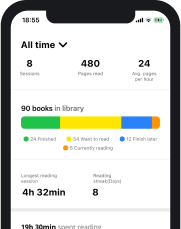Using a reading strategy has become a habit for many readers out there. The reason for this is the fact that we tend to constantly need to learn to extract top value from our very limited time. The more we manage to get done within a short timeframe, the better. It’s not easy to work our reading habits into our daily routine, even though we are all perfectly aware of the amazing benefits this would have both for our intellect and general well-being.
The SQ3R reading strategy has been proven to be extremely effective both in terms of comprehension and information retention, which puts it at the top of the list of choices among readers everywhere.
Here at Basmo, our mission is to help improve your reading habits, efficiency, and overall experience, so teaching you what the SQ3R reading strategy is and how to use it for the best results is of utmost importance.
What does SQ3R stand for?
Understanding the SQ3R meaning can only begin with knowing what SQ3R stands for. That being said, this reading technique is based on a series of actions that can help improve one’s ability to maximize performance while reading. The sequence is actually where the name of this strategy originated. That being said, SQ3R stands for:
- Survey
- Question
- Read
- Recite
- Review
This sequence of actions is the essence of the SQ3R study method or reading strategy, however you might want to call it.
Now, let’s try to dive a little deeper into its meaning and how it can help us become better readers.
What is the SQ3R reading method?
SQ3R is a reading strategy that is meant to enhance the reader’s level of comprehension and information retention in active reading sessions. The steps involved in the method force the reader to create a well-organized mental process, which aids the level of concentration and how the information is processed and absorbed.
The story of the SQ3R method begins back in 1946, when Francis P. Robinson, an American educational psychologist, first mentioned it in his book “Effective Study”. Robinson proposed the SQ3R strategy as an efficient learning tool which consisted of five important steps which are also the source of the method’s name: survey, question, read (R1), recite (R2), review (R3).
Each of the five stages of SQ3R needs to be engaged differently and requires a different level of involvement from the reader. The five steps are split into three stages:
- Before reading (Survey and Question)
- During reading (Read- R1)
- After reading (Recite and Review – R2& R3)
Having the reading session split into three distinct stages with different requirements in terms of actions and mental processes makes SQ3R a very effective and easy to implement reading strategy.
Why is SQ3R an effective reading strategy?
The ultimate goal of the SQ3R is to help readers comprehend and retain as much information as possible in one sitting. While other methods include re-reading as part of the technique, SQ3R is probably the most efficient reading strategy in terms of time management. With SQ3R, the focus is on making the most of the current reading session without the need to schedule a new one to review or consolidate the information that was acquired.
What are the advantages of the SQ3R method of reading?
- SQ3R can be a very effective way to approach a text in methodical and inquisitive manner
- SQ3R offers a process of inquiry that encourages readers to become more engaged, which increases their awareness of the reading material
- The SQ3R process is effective because the survey and question steps help readers form their own understanding of the text they will read. Additionally, it gives readers a way to check their levels of comprehension by keeping them engaged.
- Readers are guided through the process of becoming familiar with the text by the survey step. Things that are already familiar are always simpler and more pleasurable to understand.
- SQ3R promotes analytical thinking through the questioning stage. This involves the reader on a deeper level in the reading material and encourages him to form his own opinion about the facts presented in the text.
- Information retention is enhanced by the reciting stage, which helps readers transfer the data from their short-term memory to long-term memory.
Why is it important to use the SQ3R method?
The ultimate goal of your reading session is the deciding factor in the importance of SQ3R in your reading habits. If you are reading simply as a pass-time activity, then using this technique might be considered overkill to a certain extent. If you are reading to learn and you have a clear intent to understand new concepts and memorize information, then SQ3R suddenly becomes a necessity.
Why should a student use the SQ3R method?
One of the most important ways SQ3R helps readers become more efficient is the way it is dedicated to extracting the most possible value from a single reading session. As I mentioned above, the ultimate goal of reading and using SQ3R is to understand and remember everything you read without the need to do any re-reading.
That being said, it is pretty clear why maximizing the results from a reading session is of utmost importance for students in general. Being time-effective as a student can be the difference between passing and failing your exams, since the volume of information you need to learn in a relatively short timeframe is usually huge.
How many steps are in the SQ3R reading technique?
So, what is the SQ3R method? It is a sequence of five different actions that need to be performed in a specific order to yield the best results in an active reading session. These are the five steps of the SQ3R method, explained in more detail.
1. Survey
The first step of the SQ3R reading system is the survey stage. During this stage you are supposed to simply skim the text at hand in order to try and gain a superficial understanding of its contents and establish your goals for the upcoming active reading session.
You just need to look at the headings, bolded text, charts or illustrations (if available), and preface. By doing this first, you establish a comprehensive framework for the contents of the reading material, which is going to help you establish realistic expectations of what you are about to gain from the reading session and what you are about to learn.
2. Question
Also referred to as “Query,” this second stage of the SQ3R reading strategy that follows the initial preview of the text requires you to start generating questions. Try to mentally create a list of questions you think the reading material is going to provide you with answers to. You can use the information you gathered in the survey stage to form these questions.
For example, you can use the headings you went over in the first SQ3R step as a base for your questions. Alternatively, you can simply use a more general questioning method and make your questions more vague, like “What am I going to learn from this book?”
3. Read
The reading phase of the SQ3R strategy consists of an active reading session. In order for the method to be truly successful in providing you with the learning experience you desire, you need to be engaged in the text. You need to be constantly looking for answers, and you are required to analyze the material in detail.
This will ensure that you have a rewarding reading experience and that you are going to comprehend and retain information more easily. Take full advantage of the content in front of you and leave no stone unturned.
4. Recite
The fourth step of the SQ3R reading strategy, also referred to as “retrieve” or “recall,” is a particularly important one. During this stage, you are supposed to identify the answers to the questions you asked during the second step. The true magic happens because of the way you answer these questions. Instead of using quotes from the book or the exact phrasing you identify in the text, you need to try and formulate these answers using your own words.
Whether you do this orally or in writing, the effect this process has is that it helps you put the reading material in a clear context and conceptualize the content. In other words, you gain a much better level of comprehension of the new concepts you are trying to learn, and you significantly increase the amount of information you retain after the reading session.
5. Review
The last stage, as the name suggests, requires you to actually review what you have learned or what you have managed to gain from your reading session. During this stage of the SQ3R reading method, you need to mentally summarize and repeat back to yourself the information you managed to gather. That way, you actively retrieve data from your memory and gain a very clear understanding of what you actually managed to comprehend and memorize. Based on the results of this stage, you get to decide which parts of the book need more attention, if any.
As you can see, this is a complex reading strategy, and an SQ3R method example might shed some more light on the way you can use it.
How to use SQ3R with Basmo
Enjoying the advantages of the SQ3R method of reading doesn’t come easy. There is some work involved in getting the hang of implementing this strategy into your reading habits, and some dedication is required. That is why, most of the time, adding a helping hand to the mix is going to do you a lot of good.
Using a reading app like Basmo is going to make things a lot easier once you’ve decided whether the pros and cons of SQ3R justify its use in your particular situation.
Here’s why Basmo comes in handy.
Making notes while reading. With Basmo, you can easily make notes during your active reading sessions. The note-taking feature becomes instantly available as soon as you start a reading session and it allows you to jot down your thoughts easily, quickly, and efficiently. The notes remain saved within the book you are reading, and they can be formatted however you see fit. That way you can keep them well-organized and easy to read.
Keeping a reading journal. Both during the recite, question, and the review stages, it is generally a good idea to write things down. The journaling feature from Basmo allows you to keep your thoughts, ideas, questions, or whatever else you think should be left in writing in a single file. You can easily go through the entire SQ3R method with the journaling feature open on your phone in order to simply jot down ev
Final thoughts
The SQ3R reading strategy is an amazingly powerful tool if used correctly. Give it a shot with Basmo and see for yourself how much you can stand to gain from implementing it into your reading or learning habits.
Image by storyset on Freepik







